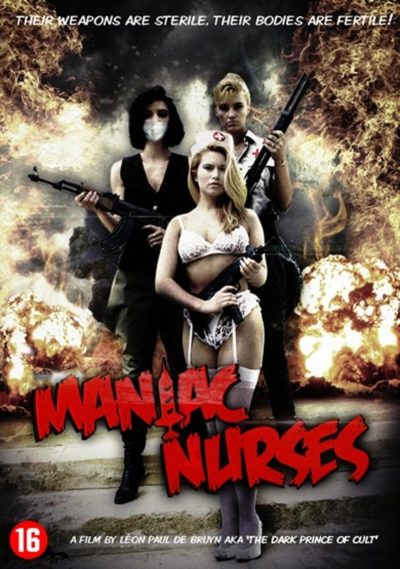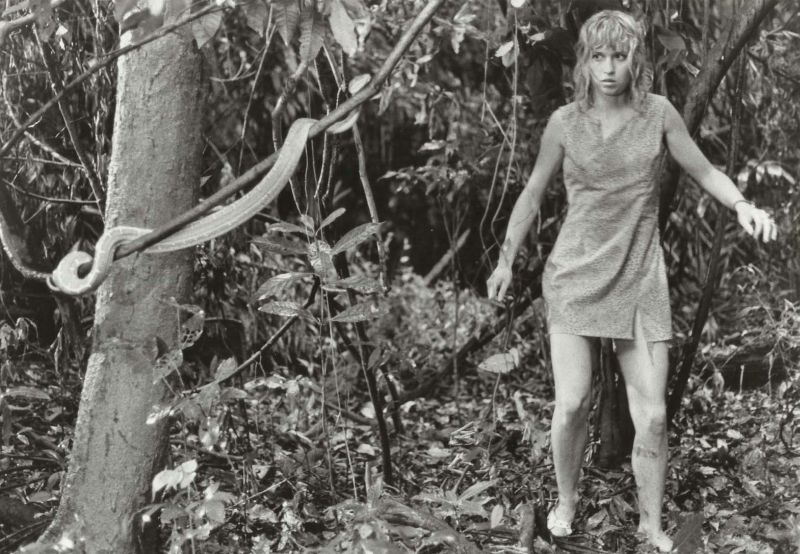★★★
“Tree’s company”
 The German-Canadian co-production is split into two feature-length parts – “Dragonfly” and “Energy” – but is absolutely a single entity, so that’s how it’ll be covered here. I was braced for something truly dreadful, after reading some particularly scathing reviews, and seeing no less than four directors listed in the credits for part one. In reality, it’s not bad. Not great, admittedly, but the three hours passed without my losing consciousness, which puts it ahead of certain recent genre entries I could mention.
The German-Canadian co-production is split into two feature-length parts – “Dragonfly” and “Energy” – but is absolutely a single entity, so that’s how it’ll be covered here. I was braced for something truly dreadful, after reading some particularly scathing reviews, and seeing no less than four directors listed in the credits for part one. In reality, it’s not bad. Not great, admittedly, but the three hours passed without my losing consciousness, which puts it ahead of certain recent genre entries I could mention.
The heroine is Sonia Engelhardt (Dordel), a scientist specializing in trees, who is carrying out research funded by a lumber company. She is on the verge of a major breakthrough when they suddenly yank her funding away. Sonia decides to proceed regardless, and in the forest, stumbles across something which puts her life in danger, along with those of local cops Bill Jones (Breker) and Analena Tempest (Reimer). They’re looking into shady ties between the lumber company, and other groups, not least a biker gang. Helping the good guys out in the subsequent investigation, with cryptic phone calls, are a shadowy, apparently governmental organization called “Libelle” (German for dragonfly, not that this is ever explained or relevant).
Part 1 ends with our trio having to high-tail it to Germany. Part 2 is much more of a solo story. Sonia gets thrown back onto her own resources – which includes, as the poster suggests, dying her originally blonde hair dark. She’s forced to become rather less of a pacifist, going all Katniss Everdeen on the baddies instead, as she eventually finds out what was going on, back in the forests of Canada. To be honest, I’d figured that revelation out quite a bit earlier (there’s a clue in the title). But as a cheerful gallop around rural Canadian and urban German landscapes, it’s not bad, and between Sonia and Analena, as well as villainess Jasmine Chang, there’s a decent quota of action heroines.
Digging into the background a bit, it appears this was originally a web series of 16 episodes, which explains both the rather odd 2-part structure, and probably also the multiple directors. It appears to have been a passion project for Dordel, who actually does hold a PhD in forest science from the University of British Columbia: she’s not just playing a scientist. As such, I can cut it some slack, and forgive the occasional rough edges. However, there are still problems too large to ignore with the script, which doesn’t flow at all, jerking abruptly from one plot point to the next, and with rather too many things happening without credible explanation, e.g. the ‘Libelle’ calls.
It’s a shame, as I like the underlying idea. A bad-ass ecologist, wielding a (very environmentally conscious!) bow and arrow against those who are destroying the planet – preferably involving the giant fireball depicted on the cover? Where do I sign up? Shame there’s a bit too much of a gap between that concept, and the execution which is delivered here.
Dir: Brent Crowell, Neil Every, Kryshan Randel, Guido Tölke
Star: Julia Dordel, Eric Breker, Anita Reimer, Michael Teigen





 That this Belgian flick starts off with a dedication to Ilona Staller (a.k.a. Italian porn star, Cicciolina), artist provocateur Jeff Koons, and Traci Lorde, likely tells you it should not be taken too seriously. Certainly, the amusement to be found largely requires the viewer to be aware of the genres to which this is a homage. This is best exemplified by the
That this Belgian flick starts off with a dedication to Ilona Staller (a.k.a. Italian porn star, Cicciolina), artist provocateur Jeff Koons, and Traci Lorde, likely tells you it should not be taken too seriously. Certainly, the amusement to be found largely requires the viewer to be aware of the genres to which this is a homage. This is best exemplified by the  ★★★★
★★★★ The WWE and women’s wrestling have had a fractious relationship over the years. For every two steps forward, there has been one – or, more often, two – backward. But under Executive Vice President of Talent Paul M. Levesque, better known by his ring-name of Triple H, there have been hopeful signs of progress. Perhaps the biggest of late was WWE staging an all-woman tournament this year, featuring 32 wrestlers from 13 different countries. This was named the Mae Young Classic, in honour of one of the field’s pioneers and longest-serving members; she wrestled from 1939 through 2008, and passed away in 2014.
The WWE and women’s wrestling have had a fractious relationship over the years. For every two steps forward, there has been one – or, more often, two – backward. But under Executive Vice President of Talent Paul M. Levesque, better known by his ring-name of Triple H, there have been hopeful signs of progress. Perhaps the biggest of late was WWE staging an all-woman tournament this year, featuring 32 wrestlers from 13 different countries. This was named the Mae Young Classic, in honour of one of the field’s pioneers and longest-serving members; she wrestled from 1939 through 2008, and passed away in 2014.
 As a joke I saw on Facebook went, “With all these self-driving cars, it won’t be long before there’s a country song about your truck leaving you.” The rise of smart vehicles is inevitable, and likely, so are other films like this, which falls somewhere between Christine and 2001. In this case, mother Sandra (Bowden) is driving to see her husband, whom she suspects of cheating on her, with their young child David (played by the two Hodges brothers, whom I’m assuming are twins!) in the back seat. Her car is the state-of-the-art Monolith, equipped with every safety feature imaginable, and then some. But a series of events – a diversion, an encounter with roadkill on the hoof, and Sandra giving David her smartphone as a distraction – lead to a tricky situation. She is stuck on a remote desert road, outside of a car that has now entered its impenetrable “vault mode”, with David trapped in its interior.
As a joke I saw on Facebook went, “With all these self-driving cars, it won’t be long before there’s a country song about your truck leaving you.” The rise of smart vehicles is inevitable, and likely, so are other films like this, which falls somewhere between Christine and 2001. In this case, mother Sandra (Bowden) is driving to see her husband, whom she suspects of cheating on her, with their young child David (played by the two Hodges brothers, whom I’m assuming are twins!) in the back seat. Her car is the state-of-the-art Monolith, equipped with every safety feature imaginable, and then some. But a series of events – a diversion, an encounter with roadkill on the hoof, and Sandra giving David her smartphone as a distraction – lead to a tricky situation. She is stuck on a remote desert road, outside of a car that has now entered its impenetrable “vault mode”, with David trapped in its interior. I say the above, since the father of the star here is Clint Eastwood, possibly the most famous vigilante in cinematic history. He gave us Dirty Harry, who memorably spat out lines such as, “When an adult male is chasing a female with intent to commit rape, I shoot the bastard – that’s my policy.” This apple doesn’t fall far from the tree. Though Noelle, the art student who becomes an avenging force after being raped at a party by a fellow student, takes a little longer to get to that point of unrepentant street justice. Her first victim is purely accidental, her attacker falling over a balcony after she confronts him, in the hope of getting some kind of apology. Doesn’t happen, and his death doesn’t exactly cause her sorrow. When she realizes she is also far from alone in what she has gone through, she decides that active retaliation is the best approach.
I say the above, since the father of the star here is Clint Eastwood, possibly the most famous vigilante in cinematic history. He gave us Dirty Harry, who memorably spat out lines such as, “When an adult male is chasing a female with intent to commit rape, I shoot the bastard – that’s my policy.” This apple doesn’t fall far from the tree. Though Noelle, the art student who becomes an avenging force after being raped at a party by a fellow student, takes a little longer to get to that point of unrepentant street justice. Her first victim is purely accidental, her attacker falling over a balcony after she confronts him, in the hope of getting some kind of apology. Doesn’t happen, and his death doesn’t exactly cause her sorrow. When she realizes she is also far from alone in what she has gone through, she decides that active retaliation is the best approach. I’m not sure if the problems here are a result of there being two authors credited on this story. It could certainly explain them. For rather than providing a single coherent vision, this feels like both its universe and characters are being pulled in too many different directions. It’s overstuffed with ideas and, instead of them being developed fully, scurries from one to the next, as if the writers were competing to have the final word. This comes to an end in a rather ludicrous finale. There, the entire plot takes a right turn, with the biological weapon which has formed much of the early focus all but discarded.
I’m not sure if the problems here are a result of there being two authors credited on this story. It could certainly explain them. For rather than providing a single coherent vision, this feels like both its universe and characters are being pulled in too many different directions. It’s overstuffed with ideas and, instead of them being developed fully, scurries from one to the next, as if the writers were competing to have the final word. This comes to an end in a rather ludicrous finale. There, the entire plot takes a right turn, with the biological weapon which has formed much of the early focus all but discarded.
 I think it was only as the end credits were rolling, that I perhaps appreciated this series fully. Sure, in many ways, these films have been a poor man’s Lord of the Rings knock-off, with a disparate band of hardy adventurers on a quest to stop Ultimate Evil (TM) from taking over. But, dammit, I found myself enjoying them, appreciating their smaller-scale charms and actually liking the characters – possibly even more than Frodo. While this finale doesn’t sustain the non-stop pace of its most recent predecessor, it does a good job of tying up all the loose ends. And if you’ve watched all five, and don’t have a slight moistness around the eyes at the end, you’ve a harder heart than I.
I think it was only as the end credits were rolling, that I perhaps appreciated this series fully. Sure, in many ways, these films have been a poor man’s Lord of the Rings knock-off, with a disparate band of hardy adventurers on a quest to stop Ultimate Evil (TM) from taking over. But, dammit, I found myself enjoying them, appreciating their smaller-scale charms and actually liking the characters – possibly even more than Frodo. While this finale doesn’t sustain the non-stop pace of its most recent predecessor, it does a good job of tying up all the loose ends. And if you’ve watched all five, and don’t have a slight moistness around the eyes at the end, you’ve a harder heart than I. ★★½
★★½ There’s an exhibition showcasing the first diamonds ever mined in Germany, dug up by the company belonging to Buhler (Kier). Keeping thing safe is the responsibility of security expert Tim (Kretschmann), who doesn’t realize that renowned jewel thief Lana (Speichert) has her eyes on the jewels. So they’re both in for a nasty surprise, because after Lana is caught by Tim in the process of stealing them, it turns out the diamonds are completely fake. Buhler gives her an ultimatum: Lana must find the real diamonds, or she’ll be handed over to the police, and to ensure she doesn’t just run off, tasks Tim with keeping an eye on her. It soon becomes clear, though, that there is more to the mystery than there appears initially, and someone is very keen to stop them from getting to the truth.
There’s an exhibition showcasing the first diamonds ever mined in Germany, dug up by the company belonging to Buhler (Kier). Keeping thing safe is the responsibility of security expert Tim (Kretschmann), who doesn’t realize that renowned jewel thief Lana (Speichert) has her eyes on the jewels. So they’re both in for a nasty surprise, because after Lana is caught by Tim in the process of stealing them, it turns out the diamonds are completely fake. Buhler gives her an ultimatum: Lana must find the real diamonds, or she’ll be handed over to the police, and to ensure she doesn’t just run off, tasks Tim with keeping an eye on her. It soon becomes clear, though, that there is more to the mystery than there appears initially, and someone is very keen to stop them from getting to the truth.